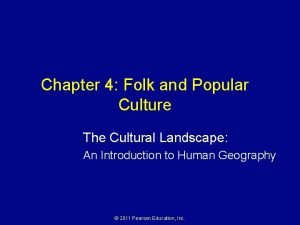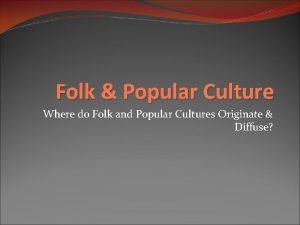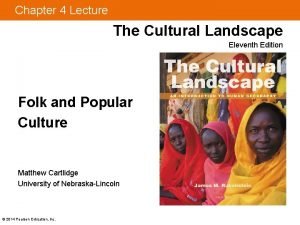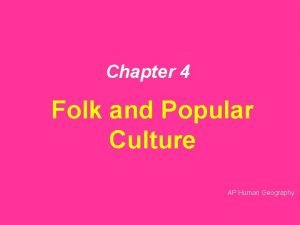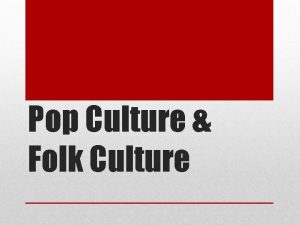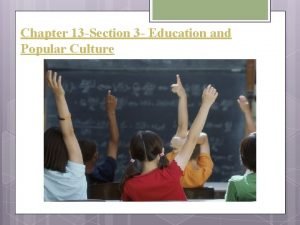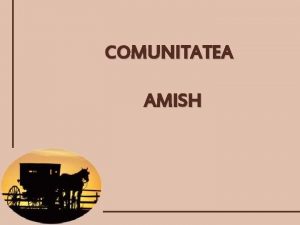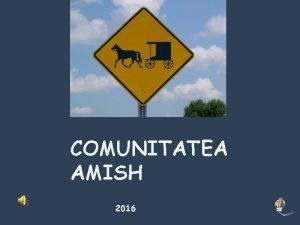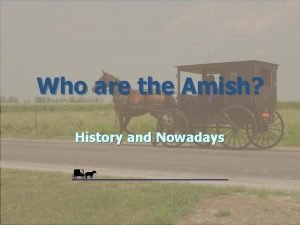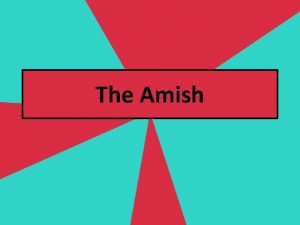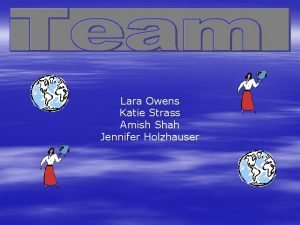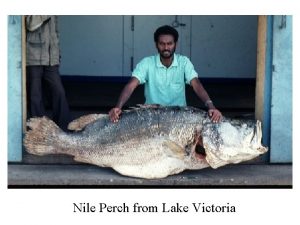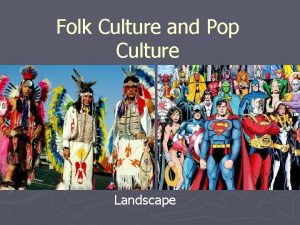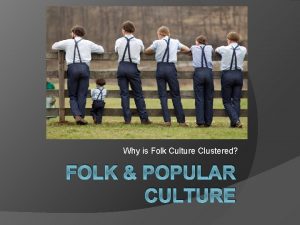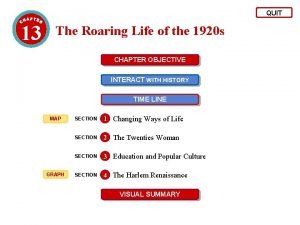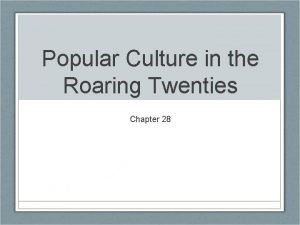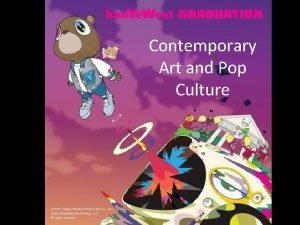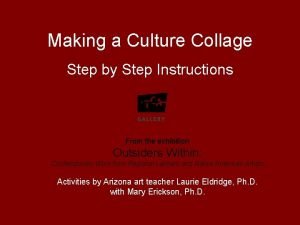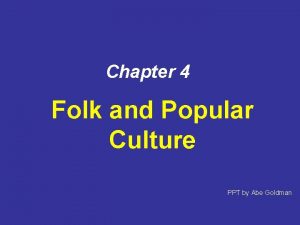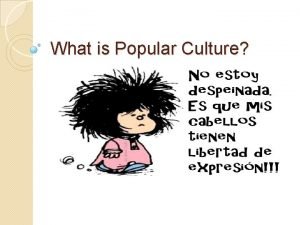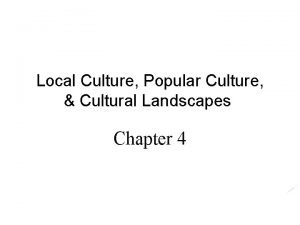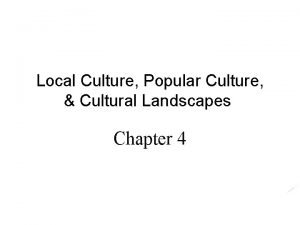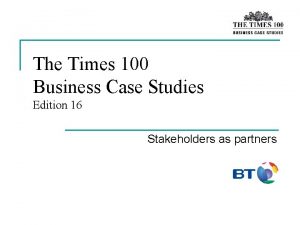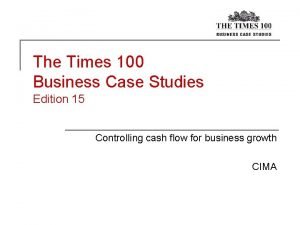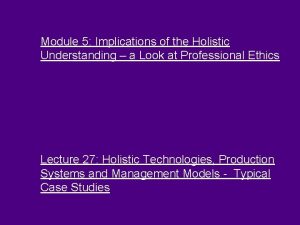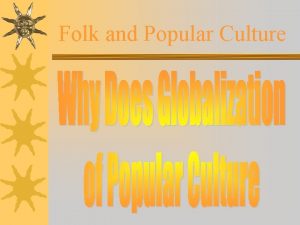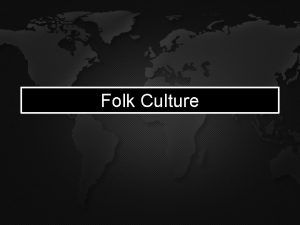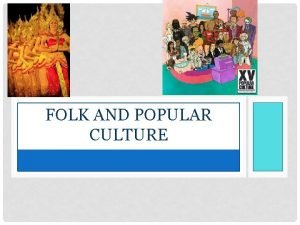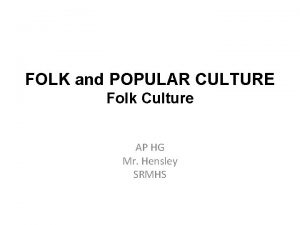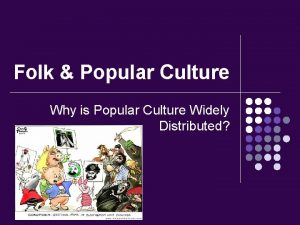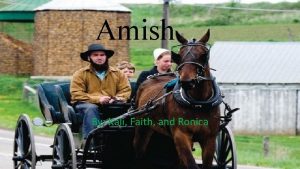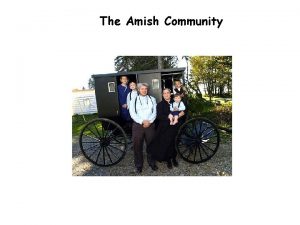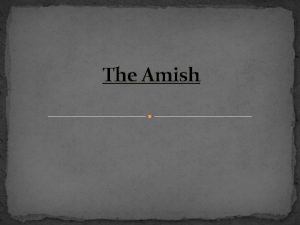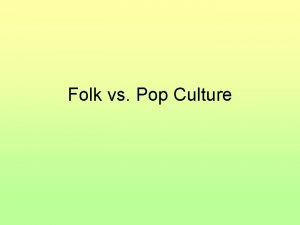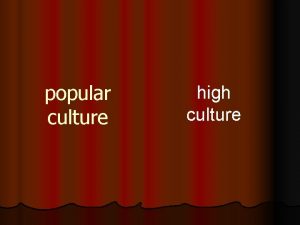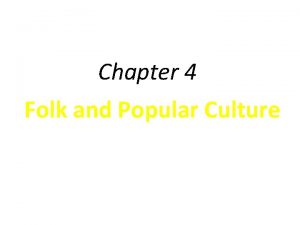Folk and Popular Culture Case Studies Amish Hutterite








































































- Slides: 72

Folk and Popular Culture: Case Studies Amish, Hutterite, and Makah

Objectives • Today we will be able to identify how culture is diffused and how folk and popular culture diffuse at different rates.

Distance Decay- the diminishing importance and eventual disappearance of a phenomenon with increasing distance from its origin. Time-Space Compressionthe reduction in the time it takes to diffuse something to a distant place as a result of improved communication and transportation systems

WHERE DO CULTURES ORIGINATE AND DIFFUSE? • Origin of folk and popular cultures – Folk culture = hearth area; originators are usually unknown – Popular culture = hearth area comes from more developed countries (MDCs) • People in MDCs have disposable income and leisure time that allow for these innovations

WHERE DO CULTURES ORIGINATE AND DIFFUSE? • Diffusion of folk and popular culture – Folk culture diffuses slowly, primarily through migration, and at a small scale • Example: Diffusion of Amish culture – Popular culture diffuses rapidly, via hierarchical diffusion, and over a large scale • Example: Sports

DISTRIBUTION OF THE AMISH

WHY IS FOLK CULTURE CLUSTERED? • Influence of the physical environment – Folk culture = close connection to the environment • Most folk cultures are rural and agricultural – Clothing is often tied to environmental conditions » Example: Wooden clogs in the Netherlands • Folk cultures cant ignore environmental conditions

WHY IS FOLK CULTURE CLUSTERED? • Influence of the physical environment – Food preferences and the environment • Food preferences are adapted to the environment – Example: In Asia, rice is grown in milder, wetter environments whereas wheat is grown in colder, drier environments • Food taboos may be especially strong – People avoid certain foods because of negative associations with that food • Terroir = the sum effects of the local environment on a particular food item

WHY IS FOLK CULTURE CLUSTERED? • Influence of the physical environment – Folk housing and the environment • Housing = a reflection of cultural heritage, current fashion, function, and the physical environment • Two most common building materials = wood and brick • Minor differences in the environment can produce very different house styles

WHY IS FOLK CULTURE CLUSTERED? • Isolation promotes cultural diversity – A group’s unique folk customs develop through centuries of relative isolation from customs practiced by other cultural groups.

MAKAH AMERICAN INDIANS A Gift From the Sea- Whaling and whales are central to Makah culture. For the Makah Tribe, whale hunting imposes a purpose and a discipline which benefits their entire community.

MAKAH AMERICAN INDIANS • The Makah hunted whales for 1500 years. They used traditional hunting canoes and harpoons. • In an 1855 treaty with the United States, they were guaranteed the right to hunt whale in the Pacific Ocean.

NEAH BAY • As more whales were hunted and killed, (high demand for whale oil) hunts would take the Makah further away from the shoreline. • In the 1920 s they decided to stop the whale hunt. • Then, the Gray Whale was put on the Endangered Species List.

MAKAH AMERICAN INDIANS • Let’s flash back to 1998… • There was no one alive among the Makahs who had ever gone whaling, but they had heard stories and songs about it all their lives. • Like their ancestors, they would paddle out in a cedar canoe and strike first with a harpoon. • But in a departure from tradition, they will use a rifle to kill the whale and at least two motorized boats to tow it home.

MAKAH AMERICAN INDIANS • “Whaling and whales have remained central to Makah culture. They are in our songs, our dances, our designs, and our basketry. Our social structure is based on traditional whaling families. The conduct of a whale hunt requires rituals and ceremonies which are deeply spiritual. Whale hunting imposes a purpose and a discipline which we believe will benefit our entire community. ” • Makah Elder, 2005

RECENT WHALING http: //www. kirotv. com/news/debate-rages-over-whether-resume-whale-hunting-was/nk 4 q. H/

IROQUOIS LEAGUE Although the Iroquois have never won the world championship they have the satisfaction of hearing their national anthem and flag fly alongside those of other participants https: //www. youtube. com/watch? v=a. Wo. Ti

HUTTERITES • Anabaptists (Amish, Mennonites) split from the Catholic Church • Let’s look at what set’s the Hutterites apart.

• Unlike the Amish, Hutterites readily accept technologies that help them in their agricultural pursuits. • However, they do NOT accept TV, camera, or cell phone technology.

COMPARING FOLK CULTURES Amish • Children traditionally dress as their parents do. • Horse drawn wagons are the favored form of transportation. • Technology is frowned upon and discouraged. • Farmers use traditional techniques. Hutterites • Live in colonies. • Colony is responsible for raising children. • Are in favor of using technology in their agricultural pursuits.

Cusco, Peru

Cusco, Peru • Cuzco, an Inca capital, is a major tourist destination. • Peruvian Clothing and Rugs • Colored with mineral or vegetable dyes • Similar products are also produced by factory machines using chemical dyes for trendy colors for appeal to mass market.

CULTURAL INTEGRATION IN FOLK GEOGRAPHY • Interaction between folk and popular cultures – Occasionally elements of folk culture penetrate the popular society – Folk handicrafts and arts often fetch high prices among city dwellers

CULTURAL INTEGRATION IN FOLK GEOGRAPHY • Interaction between folk and popular cultures – Few folk groups escape some interaction with the larger world – A lively exchange is constantly on-going between folk and popular culture

Mountain moonshine • Home manufacture of corn whiskey in the Upland South has been going on since the early pioneering days of the 1700 s • Home manufacture of whisky has occurred in many Appalachian hill settlements for 200 years


Mountain moonshine • Whiskey making withstood the prohibitionist attitudes of the nineteenth century religious revival – Many mountaineers are devout Baptists or Methodists, but defied antiliquor teachings – Corn whiskey is very persistent in the folk diet

Mountain moonshine • Traditionally corn liquor was intended mainly for family consumption • Over the years, Appalachian moonshine began to find its way to market – Proved the best way for hill folk to participate in the money economy – Converted a bulky grain crop of low cash value in a compact beverage of high value per unit of weight

Mountain moonshine • Early as 1791, the U. S. federal government began taxing manufacturers of whiskey – When stills were discovered and destroyed, new ones in different locations replaced them – Revenuers were no more successful in stopping whisky making than the churches had been


Mountain moonshine • The important effect was mountain folk accepted markets offered by popular culture but rejected its legal and political institutions • By the 1950 s, some 25, 000 gallons of white lightning reached the market each week from the counties of eastern Tennessee alone – In spite of numerous raids by federal authorities, production continued unabated – Today, a substantial amount of illicit whisky still reaches markets from southern Appalachia

Mountain moonshine • Whiskey production, legal and illegal, in Kentucky and Tennessee represents an impressive survival of folk industry to serve a market in popular society • Illegal whisky production and popular culture integration led to the creation of the “folk automobile” – A fast vehicle needed to outrun the law, but humble in appearance – Some have claimed these vehicles were the forerunners of the basic American stock car – Stock-car racing then is considered another result of interplay between folk and popular cultures • https: //www. youtube. com/watch? v=ug 8 p 5 p. Vsj 9 U

Popular Culture

Popular Culture Effects on Landscape: leads to homogenous, “placeless”, landscape · Complex network of roads and highways · Commercial Structures tend towards ‘boxes’ Planned and Gated Communities more and more common Disconnect with landscape: indoor swimming pools, desert surfing, indoor ski resort in Dubai.

Surfing in Tempe, Arizona Are places still tied to local landscapes?

Wave Pool in Tokyo

Ski Dubai?

Mc. Donald’s, Tokyo Japan What is the goal with this places? Swimming Pool, West Edmonton Mall, Canada Mc. Donald’s, Jerusalem

Problems with the Globalization of Culture Often Destroys Folk Culture – or preserves traditions as museum pieces or tourism gimmicks. · Mexican Mariachis · Change in Traditional Roles and Values Satellite Television, Baja California

Environmental Problems with Cultural Globalization Accelerated Resource Use through Accelerated Consumption • Furs: minx, lynx, jaguar, kangaroo, whale, sea otters (18 th Century Russians) fed early fashion trends • Inefficient over-consumption of Meats, Poultry, even Fish by meat-eating pop cultures · Mineral Extraction for Machines, Plastics and Fuel · New Housing and associated energy and water use.

Environmental Problems with Cultural Globalization Pollution: waste from fuel generation and discarded products, plastics, marketing and packaging materials Consumption: accelerating consumption trends


Urban Sprawl = Progress?

“They’re growing houses in the fields between the towns. ” - John Gorka, Folk Singer

Also Malvina Reynolds Boxes” which “They’re growing houses in“Little the fields between the was towns. ” popularized through television shows. - John Gorka, later Folk Singer

Beijing, China Palm Springs, CA

Pop Culture- Significance of THEMES. A golf course in Beijing is likely to look similar to a golf course in Palm Springs. Pick another cultural trait to share an example. Beijing, China Palm Springs, CA

WHERE DO CULTURES ORIGINATE AND DIFFUSE? • Origin of folk and popular music – Folk music characteristics • Tells a story or recounts important life events or activities • Is personal in nature – Popular music characteristics • Written by individuals for the purpose of selling to a large audience • Highly technical

HIP HOP MAP Hip-hop is fascinating because songs can gain worldwide attention by discussing local areas!

• 1970 s- Local birth of hip hop mixing styles of soul, jazz, Jamaican beats, and emceeing (Bronx, New York, Block Parties) • 1980 s- New School Hip Hop (LL Cool Jay, Run DMC, LATE 80 s Beastie Boys) • 1990 s- Gangsta Rap and West Coast (Straight Outta Compton, Iced T’s Body Count) • Mainstream Breakthrough- Bush and Clinton Admins criticized the genre– so of course more people listen! Songs focused on issues in traditionally African American communities.


Much of the Elvis adoration lies in the east. What are some cultural influences that contribute to this “fault line” in the geography of popular culture.

Why Is Access to Folk andof Popular Culture Unequal? • Electronic Diffusion Popular Culture – Principal obstacle to accessing popular culture is lack of access to electronic media. • Most important electronic media format to popular culture is TV for two reasons. 1. Watching TV is most popular leisure activity in the world. 2. TV is most important mechanism for rapidly diffusing popular culture around the world.


How does this reflect the popular culture mainstream for common leisure activity for Americans?

Why Is Access to Folk and Popular Culture Unequal? • Electronic Diffusion of Popular Culture – Diffusion of TV: Mid-Twentieth Century • TV technology originated simultaneously in multiple hearths in the early twentieth century— e. g. , UK, France, Germany, Japan, Soviet Union, and the United States. • Over the course of the twentieth century, the United States went from dominating the world share of TVs to being nearly equal in rates of ownership with most developing countries.


Television has diffused from North America and Europe to other regions of the world. The United States and Canada had far more TV sets per capita than any other country as recently as the 1970 s, but several European countries now have higher rates of ownership.

Why Is Access to Folk and Popular Culture Unequal? • Electronic Diffusion of Popular Culture – Diffusion of the Internet: Late Twentieth Century • Diffusion follows pattern established by TV but at a more rapid rate. • In 1995, Internet users in the United States accounted for more than half of the global users.

• By 2011, 77 percent of the U. S. population accessed the Internet. – Accounted for 10 percent of the global users. » Global share decreased by roughly 40 percent in less than 10 years.


Internet service is following a pattern in the twenty-first century similar to the pattern of diffusion of television in the twentieth century. The United States started out with a much higher rate of usage than elsewhere, until other countries caught up. The difference is that the diffusion of television took a half-century and the diffusion of the Internet only a decade.

Why Is Access to Folk and Popular Culture Unequal? • Electronic Diffusion of Popular Culture – Diffusion of Social Media: Twenty-First Century • Same diffusion pattern as TV and Internet – Facebook » In 2008, Facebook users in United States consisted of 1/3 of all global users. » By 2011, global share decreased to 1/5. – Twitter » United States was source of 1/3 of all tweets in 2010. » Second leader of tweets is India.


How was Twitter different from other social media outposts when it began?

Why Is Access to Folk and Popular Culture Unequal? • Challenges in Accessing Electronic Media – External Threat: Developed Countries Control the Media • TV industry dominated by Japan, UK, and United States. • Leaders of developing countries could view dominance as impressing American values upon viewers. – – Upward social mobility Freedom for women Glorification of youth Stylized violence

Why Is Access to Folk and Popular Culture Unequal? • Challenges in Accessing Electronic Media – External Threat: Developed Countries Control the Media • News – News media in developing countries dominated by the government, whereas media in the United States is largely private commercial stations. – Many African and Asian government officials criticize freedom of the press in the United States. » Allegedly media do not convey an accurate view of other countries.

Western Media Imperialism? · U. S. , Britain, and Japan dominate worldwide media. · Common themes include: consumerism, violence, sexuality, and militarism · U. S. (Networks and CNN) and British (BBC) news media provide/control the dissemination of information worldwide. · These networks are unlikely to focus or provide third world perspective on issues important in the LDCs.

• Challenges in Accessing Electronic Media – Internal Threat: Social Media • Limiting Access to TV – Satellite dishes enable people to access information that would otherwise be censored by their governments. • Some governments attempt to limit Internet content including: 1. Political Content » Opposition to local government 2. Social Content » Socially sensitive material, such as gambling or sex 3. Conflict and Security » Armed conflict, border disputes, or militant groups 4. Internet Tools » Email, Internet hosting, and Internet searches


Countries limit access to four types of Internet content: (top) political content, (second) social content, (third) security content, (bottom) Internet tools.

Music and Culture • Find an example of a folk song and an example of a popular song. (2 songs total) • Print out the lyrics. * If in another language, translate! • Conduct a geographic analysis. Your analysis should answer the following questions: – – – What is the song about? Where is the song about? How does it reach its intended audience? Is it successful in reaching its intended audience? What do folk and popular songs have in common? How do they differ? Conduct a write up on your song reflecting these themes. Your writing should be succinct, scholarly, and reflect themes from the course!
 Folk culture and popular culture venn diagram
Folk culture and popular culture venn diagram Chapter 4 folk and popular culture
Chapter 4 folk and popular culture Folk culture and popular culture venn diagram
Folk culture and popular culture venn diagram Amish folk culture
Amish folk culture Folk and popular culture
Folk and popular culture Chapter 4 folk and popular culture
Chapter 4 folk and popular culture How do the origins of folk and popular culture differ?
How do the origins of folk and popular culture differ? Chapter 4 folk and popular culture
Chapter 4 folk and popular culture Examples of folk and popular culture
Examples of folk and popular culture Why is access to folk and popular culture unequal
Why is access to folk and popular culture unequal Folk songs ap human geography
Folk songs ap human geography Example of folk culture ap human geography
Example of folk culture ap human geography Whats pop culture
Whats pop culture Mass media and popular culture
Mass media and popular culture Chapter 13 section 3 education and popular culture
Chapter 13 section 3 education and popular culture Steamboat willie
Steamboat willie Daily life and popular culture in the 1950s
Daily life and popular culture in the 1950s Define rumspringa
Define rumspringa What is directional selection
What is directional selection Comunitatea amish
Comunitatea amish Amish casatorie
Amish casatorie Amish clothing history
Amish clothing history Weird amish names
Weird amish names Jennifer holzhauser
Jennifer holzhauser Christian denominations chart
Christian denominations chart Amish catholic
Amish catholic Inbreeding in humans pictures
Inbreeding in humans pictures Comunitatea amish
Comunitatea amish Best worst and average case
Best worst and average case Threats to folk culture
Threats to folk culture Where does the 100 take place
Where does the 100 take place Folk culture sports
Folk culture sports Hearth of folk culture
Hearth of folk culture Definition of folk culture
Definition of folk culture Why is folk culture clustered?
Why is folk culture clustered? What is that ?
What is that ? 1920 popular culture
1920 popular culture Chapter 28 popular culture in the roaring twenties
Chapter 28 popular culture in the roaring twenties Stuart hall 1981
Stuart hall 1981 Pop culture theme
Pop culture theme Culture collage
Culture collage Learning english through popular culture
Learning english through popular culture Chapter 19 section 3 popular culture
Chapter 19 section 3 popular culture Rapid diffusion of popular culture
Rapid diffusion of popular culture Universalization of pop culture
Universalization of pop culture Popular culture images
Popular culture images Popular culture ppt
Popular culture ppt Why does globalization of popular culture cause problems?
Why does globalization of popular culture cause problems? поп музика
поп музика Features of popular culture
Features of popular culture Pop culture raymond
Pop culture raymond What is popular culture
What is popular culture Example of material culture
Example of material culture What is pop culture
What is pop culture What is popular culture
What is popular culture What is popular culture
What is popular culture Popular culture diffusion
Popular culture diffusion Paradigm shift from women studies to gender studies
Paradigm shift from women studies to gender studies Popular case tools
Popular case tools Case tools definition
Case tools definition Example of outbreak
Example of outbreak Prospective and retrospective difference
Prospective and retrospective difference Batch culture vs continuous culture
Batch culture vs continuous culture Difference between american culture and indian culture
Difference between american culture and indian culture Stab culture and stroke culture
Stab culture and stroke culture Indole test
Indole test Anaerobic culture method
Anaerobic culture method Carpet culture method
Carpet culture method Surface culture deep culture and esol
Surface culture deep culture and esol Advantages of case studies in psychology
Advantages of case studies in psychology Times 100 case studies
Times 100 case studies Times 100 case studies
Times 100 case studies Holistic technology in human values
Holistic technology in human values





